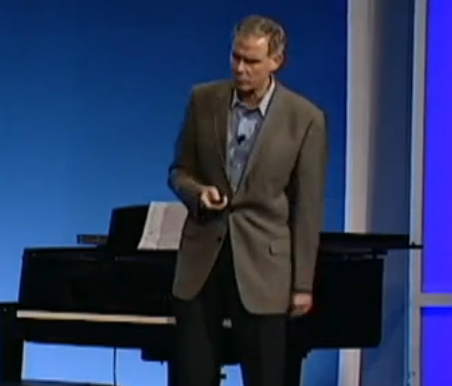(单词翻译:单击)
听力文本
OK. So, that's the first night. And this one is now 67, and that's not a good score.
好的,这是第一个晚上。这天晚上我得了67分,这不是很好的分数。
And this tells you, of course, how much you had in REM sleep, in deep sleep, and all this sort of thing.
这个还告诉你,你分别处于快速眼动睡眠、深度睡眠或其他睡眠状态的时间。
This was really fascinating because this gave that quantitation about all the different phases of sleep.
这的确很有趣,因为它为你睡眠的各个阶段进行定量分析。
So, it also then tells you how you do compared to your age group.
而且,Z.Q.也可以帮助你与你同龄组的人进行比较。
It's like a managed competition of sleep. And really interesting stuff.
这好像是一个睡眠竞争比赛。非常有趣。
Look at this thing and say, "Well, I didn't think I was a very good sleeper,
我看到这个结果,然后想:“虽然我的睡眠质量不算好,
but actually I did better than average in 50 to 60 year olds."
但与50~60岁年龄组的平均水平相比还是很不错的。”
OK? And the key thing was, what I didn't know, was that I was a really good dreamer.
重要的是,我竟然不知道我睡觉的时候经常做梦。
OK. Now let's move from sleep to diseases.
好的,让我们再从睡眠转向疾病。

Eighty percent of Americans have chronic disease,
80%的美国人都患有慢性疾病,
or 80 percent of age greater than 65 have two or more chronic disease,
高于65岁的美国人中80%以上患有两种或多种慢性疾病,
140 million Americans have one or more chronic disease,
1.4亿美国人有一种或多种慢性疾病,
and 80 percent of our 1.5, whatever, trillion expenditures are related to chronic disease.
我们的1.5万亿医疗开销中80%与慢性疾病有关。
Now, diabetes is one of the big ones. Almost 24 million people have diabetes.
糖尿病就是其中人数最多的一种。在美国,几乎有2400万人患有糖尿病。
And here is the latest map. It was published just a little more than a week ago in the New York Times, and it isn't looking good.
这是《纽约时报》上星期发表的最新疾病地图,看起来情况不是很好。
That is, for men, 29 percent in the country over 60 have Type II diabetes,
在美国,60岁以上的男性中29%患有II型糖尿病,
and women, although it's less, it's terribly high.
女性较男性人数虽少一些,但数目还是相当巨大。
演讲介绍
EricTopol说,我们很快就可以通过智能手机来监控我们的生命体征并监测一些慢性疾病。在TEDMED上,他着重介绍了应用在未来医疗上的一些重要无线装置,这些装置可以帮助我们远离医院的病床。


